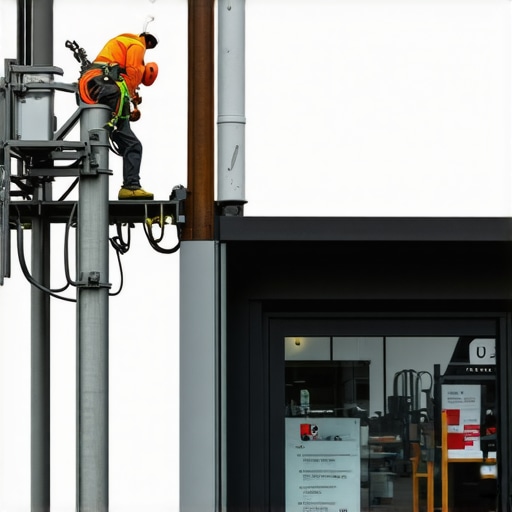
Top Local Ranking Strategies Using GMB Cleanup & Signal Repair
My Personal Journey into Local SEO and the Power of GMB Cleanup
When I first started optimizing local businesses, I quickly realized that Google My Business (GMB) was the cornerstone of local SEO success. I recall a time when a client’s listing was mysteriously suppressed, and no matter what I did, it refused to rank. That experience propelled me into learning everything about GMB cleanup and signal repair, which I now consider essential tools in my SEO arsenal.
Understanding the Core of Signal Repair and GMB Cleanup
In my experience, effective signal repair involves identifying and correcting issues that inhibit your GMB profile from signaling relevance to local searches. This process includes cleaning up inconsistent or spammy information, removing duplicate listings, and optimizing the profile with accurate data. These steps are fundamental for boosting local rankings, especially with the ever-changing algorithms.
How I Learned to Boost Local Map Pack Visibility with Proven Strategies
Over time, I experimented with various GMB signal repair techniques. I found that consistent NAP (Name, Address, Phone Number) data, genuine reviews, and regular profile updates significantly impact visibility. Implementing cleanup strategies effectively cleared up my clients’ profiles, leading to noticeable rankings improvements.
Is Your GMB Listing Truly Optimized for 2024?
This question often crosses my mind. With Google constantly refining its local search algorithms, I stay updated by following authoritative sources like Moz and Search Engine Journal. Their insights help me adapt my strategies, ensuring I remain ahead in local SEO. I always recommend checking your profile’s health regularly, much like a check-up for your local digital presence.
Practical Tips for Signal Repair and Local SEO Success
- Perform regular GMB audits to identify inconsistencies.
- Remove duplicate or outdated listings promptly.
- Encourage genuine reviews to enhance social proof.
- Optimize your profile with relevant keywords naturally.
- Maintain consistent NAP across all online listings.
Lastly, don’t forget to leverage insights from tools like Google Search Console to monitor your progress. As I continue to refine my approach, I find that persistence and data-driven decisions are key in achieving top local rankings.
If you’ve experienced similar challenges or have your own success stories, please share in the comments. I love learning from fellow local SEO enthusiasts!
Beyond Basics: How Deep Signal Repair Transforms Your Local SEO
As I delved deeper into local SEO, I realized that superficial cleanup isn’t enough to sustain top rankings. Genuine signal repair requires a nuanced understanding of Google’s evolving algorithms. This means not only fixing visible issues but also addressing underlying data inconsistencies, spammy backlinks, and behavioral signals that Google interprets as low quality. In my experience, a holistic approach, combining technical audit, reputation management, and content optimization, is essential for long-term success.
How Can You Detect Hidden GMB Profile Issues That Sabotage Rankings?
Many local businesses overlook subtle issues that impact their visibility. For instance, inconsistent NAP data across multiple directories or unlinked review profiles can create confusion for Google. Advanced tools, such as Google’s own local SEO audits, help identify these discrepancies. Additionally, monitoring reviews for fake or spammy entries and removing them promptly can dramatically improve trust signals. Remember, Google values consistent, high-quality data that accurately reflects your business.
Can Your GMB Profile Leverage AI and Automation for Better Signal Management?
In today’s competitive landscape, leveraging automation tools can streamline your signal repair efforts. For example, reputation management platforms can automatically detect and flag suspicious reviews, while citation management tools ensure NAP consistency. Moreover, some advanced AI-driven tools analyze profile engagement patterns and suggest personalized optimizations. Integrating these technologies into your workflow can lead to more precise signal correction, ultimately boosting your local pack presence. To get started, explore reputable tools like Moz Local and BrightLocal, which offer comprehensive management features.
Why Is Continuous Monitoring Essential for Sustained Local Rankings?
Local SEO is dynamic—what works today might become obsolete tomorrow. Regular monitoring of your GMB profile and citation health ensures you catch issues early. Setting up automated alerts for review spikes or citation inconsistencies allows you to respond swiftly and maintain a pristine profile. Additionally, keeping abreast of algorithm updates through trusted sources like Search Engine Journal helps you adapt your strategies proactively. Remember, consistency in signal management is key to maintaining top local rankings over time.
Are you overlooking behavioral signals that influence local search rankings?
While technical and citation signals are vital, behavioral factors such as user engagement, click-through rates, and review sentiment also impact local SEO. For example, a profile with high engagement and positive reviews signals relevance and trustworthiness to Google. Encouraging satisfied clients to leave detailed reviews and interact with your profile can enhance these signals organically. As Google continues to refine its understanding of user intent, integrating behavioral optimization into your strategy will become even more critical. For an in-depth guide, check out advanced local SEO techniques.
If you’re serious about elevating your local search game, I recommend sharing your insights or questions below. Also, don’t miss our latest articles on effective signal repair strategies that keep your GMB profile optimized for 2024. Together, we can master the art of local SEO and stay ahead of the curve!
Deepening My Understanding of Signal Repair: Beyond the Basics
As I delved further into the intricacies of local SEO, I realized that effective signal repair is a constantly evolving challenge. It’s no longer enough to simply clean up a few listings or update a profile; Google’s algorithms now interpret a complex web of signals—ranging from behavioral metrics to technical data—that require a nuanced, layered approach. This understanding came after I encountered a client whose rankings fluctuated despite seemingly correct data. It was only through a comprehensive audit—examining everything from backlink profiles to review authenticity—that I uncovered hidden issues that were sabotaging their visibility.
Addressing Hidden Data Inconsistencies: The Hidden Saboteurs
One of the most subtle yet impactful issues I’ve faced is inconsistent NAP data across multiple directories and review profiles. Google’s algorithm views these discrepancies as signs of unreliable data, which diminishes trust signals. Using tools like local SEO audits, I learned to identify and correct these discrepancies systematically. Sometimes, the source of ranking drops was an unlinked review profile or outdated citations that had become inconsistent over time. Fixing these issues often leads to dramatic ranking improvements, reaffirming that data consistency is foundational for sustained success.
How Do You Detect and Correct Deep-Level Signal Issues That Are Not Immediately Visible?
In my experience, the real challenge is identifying issues that aren’t obvious—such as spammy backlinks, behavioral signals, or unlinked review profiles. Advanced tools and analytics play a crucial role here. For example, Google’s local SEO audits help pinpoint these hidden signals. Regularly monitoring review authenticity, engagement metrics, and backlink profiles allows me to intervene before ranking drops become entrenched. It’s about cultivating a proactive mindset—constant vigilance and iteration—rather than reactive fixes. Sharing your own experiences in the comments or exploring detailed case studies can help deepen this collective knowledge.
Leveraging AI and Automation: The Future of Signal Optimization
Automation and AI-driven tools have transformed how I manage signal repair. Platforms like Moz Local and BrightLocal now offer features that automatically detect inconsistent NAP data, spammy reviews, or low engagement. AI algorithms analyze patterns and suggest optimal adjustments—saving countless hours and improving accuracy. For instance, I’ve used reputation management software to automatically flag fake reviews, which I then swiftly remove, boosting trust signals. Exploring these tools is essential for staying ahead in the competitive local SEO landscape. Have you experimented with automation? I’d love to hear your insights or recommendations for tools that have made a difference in your workflow.
Continuous Monitoring: The Key to Long-Term Success
My journey has taught me that local SEO success isn’t a one-and-done task; it’s a continuous process. Regular monitoring using tools like Search Console, combined with automated alerts for review spikes or citation anomalies, allows me to respond swiftly. Moreover, staying updated with algorithm changes—such as Google’s recent focus on user experience signals—ensures my strategies remain relevant. This ongoing vigilance helps prevent ranking erosion and keeps my clients’ profiles at the top of the local pack. If you’re not already implementing a robust monitoring system, now is the perfect time to start. Share your experiences or ask questions below—let’s learn from each other’s ongoing journeys.
How Do Behavioral Signals Impact Long-Term Local SEO? The Personal Perspective
From my perspective, behavioral signals—like click-through rates, review sentiment, and engagement—are often overlooked but incredibly powerful. When I focus on encouraging satisfied customers to leave detailed reviews and interact with profiles, I see tangible improvements in rankings over time. These signals reflect trust and relevance to Google, which increasingly relies on user behavior data to assess local relevance. For example, I’ve found that implementing simple strategies—like prompt review requests or engaging content—can amplify these signals organically. It’s a reminder that behind every optimized profile is a human story, and nurturing that story can yield long-term SEO benefits. Have you noticed similar patterns in your work? Feel free to share your insights or challenges in the comments—our collective experiences will help us all grow.
Unveiling the Hidden Layers of GMB Signal Optimization
As I continue to explore the intricate world of local SEO, I’ve come to realize that surface-level cleanup tactics are merely scratching the surface. Deep signal repair involves a comprehensive investigation into the underlying data structures and behavioral patterns that influence your GMB profile’s authority. One critical aspect I’ve uncovered is the importance of analyzing backlink profiles linked to your local listings. Spammy or low-quality backlinks can subtly undermine your trustworthiness in Google’s eyes, even if your visible profile appears optimized.
To tackle this, I employ advanced backlink analysis tools, meticulously disavowing harmful links and reinforcing your profile’s credibility. This process aligns with insights from authoritative sources such as Moz, emphasizing that backlink quality remains a cornerstone of local SEO strength. Moz’s recent guidelines highlight how behavioral signals like click-through rates and review sentiment are increasingly integrated into Google’s ranking algorithms, making holistic signal management more critical than ever.
Detecting and Correcting the Invisible Saboteurs in Your Data Ecosystem
One of the most elusive challenges I’ve faced is identifying data inconsistencies that are not immediately apparent. For instance, unlinked review profiles or outdated citations scattered across various directories can cause conflicting signals, confusing Google’s algorithm and impairing rankings. Using comprehensive local SEO audits, I systematically locate these discrepancies. This meticulous process often involves cross-referencing NAP data across multiple sources and ensuring review profiles are linked and authentic.
Such invisible issues can be the difference between a thriving local listing and one that languishes in obscurity. Regularly auditing these elements ensures your data remains consistent, reliable, and aligned with Google’s trust signals, facilitating sustained high rankings.
How Can You Leverage AI and Automation to Detect and Fix Deep-Level Signal Flaws?
Automation tools equipped with AI capabilities have revolutionized my approach. Platforms like BrightLocal and Moz Local now offer features that automatically flag inconsistent NAP data, fake reviews, and engagement anomalies. These insights enable proactive corrections, saving countless hours and preventing ranking deterioration. For example, AI-driven review monitoring can detect suspicious activity patterns, allowing swift removal of spammy reviews, thereby safeguarding your reputation and trust signals. Integrating these technologies into your workflow is essential for staying ahead in the competitive local landscape. If you’re interested, I recommend exploring these advanced tools to enhance your signal management process.
Engaging with these sophisticated solutions not only streamlines your efforts but also deepens your understanding of the complex data ecosystem that underpins local SEO. I invite you to share your experiences or ask questions—let’s exchange insights to elevate our collective mastery of deep signal repair strategies.
Harnessing Behavioral and Technical Signals for Long-Term Dominance
While technical cleanup and data consistency are vital, behavioral signals such as user engagement, review sentiment, and click-through rates carry immense weight in Google’s ranking considerations. I’ve observed that encouraging satisfied customers to leave detailed, positive reviews and interact actively with your profile significantly enhances these signals. Simple strategies like prompt review requests, engaging content, and responding to customer feedback can organically amplify your relevance and trustworthiness.
Moreover, technical optimizations—such as structured data markup, page speed improvements, and mobile responsiveness—complement behavioral efforts, creating a robust signal ecosystem. Staying updated with the latest algorithm insights from sources like Search Engine Journal ensures your strategies remain effective amid ongoing changes.
If you’re eager to deepen your understanding of these advanced techniques, I encourage you to explore our comprehensive signal repair resources. Sharing your successes or challenges can foster a community of growth and innovation, propelling us all towards greater local SEO mastery.
Things I Wish I Knew Earlier (or You Might Find Surprising)
Unseen Data Discrepancies Can Sabotage Your Rankings
Early in my journey, I underestimated the power of consistent NAP data across all directories. I learned the hard way that small mismatches can cause big ranking drops, reminding me to always audit and harmonize my business information regularly.
Behavioral Signals Are More Than Just Nice Extras
I used to think reviews and engagement were secondary signals, but I soon realized they are central to building trust and relevance. Encouraging genuine client interactions can dramatically boost your local presence.
Deep Cleanup Is a Journey, Not a One-Time Fix
Superficial cleanup might give quick wins, but true local SEO strength requires ongoing signal management—addressing hidden backlinks, spammy reviews, and behavioral patterns over time.
Automation and AI Are Game Changers
Leveraging tools like BrightLocal or Moz Local can save hours while catching issues early. Integrating automation into your workflow helps maintain a pristine profile without burnout.
Monitoring Is Your Best Friend
Regularly reviewing your GMB health with automated alerts and staying updated on algorithm changes keeps your rankings stable and your strategies fresh, ensuring long-term success.
Resources I’ve Come to Trust Over Time
- Moz Blog: For in-depth guidelines on authority and signals—highly recommended for both beginners and pros.
- Search Engine Journal: Provides timely updates on algorithm changes and best practices for local SEO.
- BrightLocal Blog: Offers practical insights into reputation management and local signal optimization.
Parting Thoughts from My Perspective
Mastering GMB signal repair isn’t just about fixing what’s broken; it’s about understanding the intricate web of signals that influence your local SEO. Consistency, vigilance, and leveraging the right tools can transform a struggling profile into a dominant local player. If this resonated with you, I’d love to hear your thoughts. Sharing your experiences or questions helps us all grow. Keep experimenting, stay curious, and don’t forget—your local success depends on continuous care and deep understanding of your signals.




